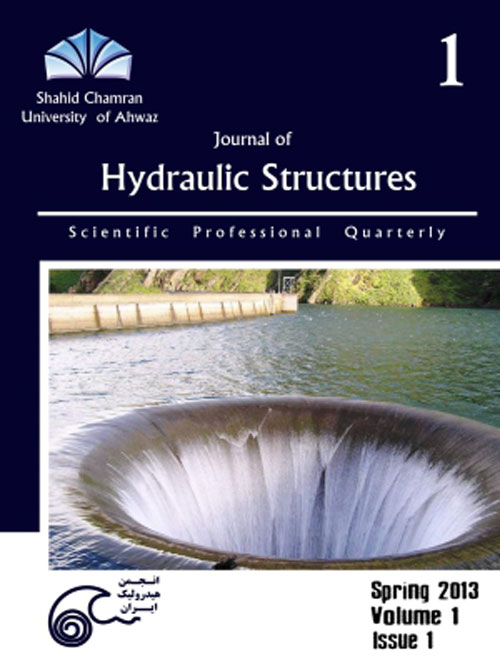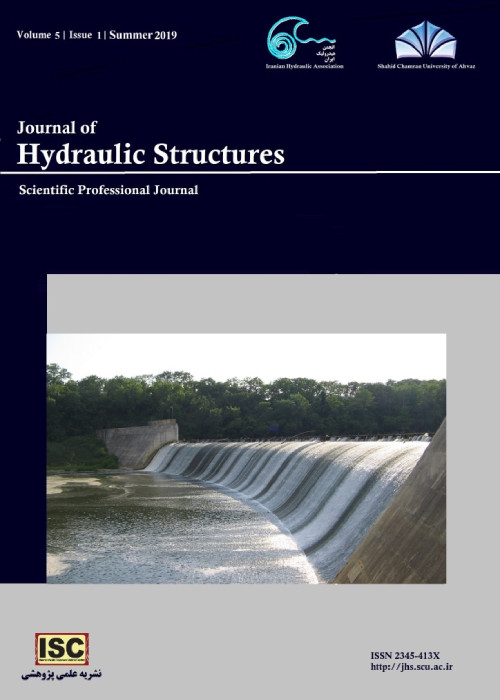فهرست مطالب

Journal of Hydraulic Structures
Volume:1 Issue: 1, Winter 2013
- تاریخ انتشار: 1395/01/20
- تعداد عناوین: 6
-
-
Pages 1-10The effect of a combined system of the bed suction and jet injection as a pier-scour countermeasure on the turbulent flow field is studied in a laboratory flume using an Acoustic Doppler Velocimeter (ADV). The three components of the velocities in the vertical symmetry plane in the equilibrium scour hole in front and rear of the pier under 3-jet injections and bed suction rate Qs/Q0 = 2%located between 0Keywords: Pier scour, jet, turbulence, bed suction, injection
-
Pages 11-23In this paper, effects of the cross shore and groyne wall slopes on flow parameters around an impermeable groyne were considered using a three-dimensional numerical CFD model (i.e., FLUENT). The k-ε turbulence model was used to evaluate the Reynolds stresses. The model was first applied to a vertical groyne on a flat bed and the model results were compared with the relevant experimental data. The results of this numerical test showed good agreements with the corresponding experimental measurements, in terms of water elevation, velocity magnitudes and reattachment length. The model was then applied to a series of structures with different lateral wall slopes on various cross sectional bed slopes. The numerical model results revealed that by increasing the cross shore bed slope in any case of the structural slopes, the magnitude of the maximum velocity and bed shear stresses decreased. These values decreased further as the structural slope reduced.Keywords: Flow characteristics, Bed shear stress, Impermeable groyne, Bed, structural slopes, Turbulence model, Numerical simulati
-
Pages 24-36An experiment featuring waterhammer in viscoelastic pipes is presented in which the effects of pipe-wall viscoelasticity on waterhammer pressures are investigated. A large-scale pipeline apparatus made of polyvinyl chloride (PVC) at Deltares, Delft, The Netherlands, has been used to carry out waterhammer experiments. Tests have been conducted in a reservoir-pipeline-valve system consisting of a main viscoelastic pipeline and two short steel pipes placed upstream and downstream of the main pipe. Rapid closure of a manually operated valve at the downstream end generates waterhammer. Repeated measurements at several positions along the pipeline have been recorded; these are plotted in figures and appropriately interpreted.Keywords: Waterhammer, Viscoelasticity, PVC, Pipe, Experiment
-
Pages 37-43In river meandering, when flow passes through a bend, reduction of flow velocity and rising hydrostatic pressure cause super elevation phenomena at outer side and reduction of water surface at inner-side of the bend. A helical motion results, causing erosion of the outer side of the bend. Installation of submerged vanes on the stream bed can reduce erosion of the outer bank significantly. In this study, to investigate the effect of shape on van effectiveness, a physical model with a rectangular-section canal of 110*0.73*0.35(m) dimensions with two 90° and 180° bends, has been constructed. Overall 28 experiments were performed, using three shapes of submerged vanes (flat, angled and curved). These vanes were installed on the bed of 90° and 180° bends of model with arrays of one, two and three vanes in parallel and zigzag patterns. Three curved vanes installed in parallel pattern on 90°-bend and zigzag pattern on 180-bend can be more effective in river bank protection.Keywords: Sediment transport, submerged vanes, River bend, angled vanes, curved vanes
-
Pages 44-53Typically, best management practices (BMPs) are implemented to help sustainable stormwater management in urban areas. Over recent decades the selection of urban stormwater management measures for a site has been a challenge among urban planners where thecriterion based on flood volume no longer suffices for selecting urban drainage solutions. Therefore there is a need to consider a set of holistic criteria beyond runoff and inundation objectives by which it would be possible to evaluate sustainability of urban drainage projects. Frequent urban flooding events have justified the use of resilience concept and pertaining criteria. This paper proposes a methodology to verify the sustainability of BMPs projects alongside their resilience. The multi criteria decision making (MCDM) technique has been applied for BMPs ranking based on proposed criteria. The methodology has been applied to urban drainage system of a municipal district of Tehran (Iran). Results indicate the effects of managers preferences on selecting BMPs. The proposed methodology provides an effective tool for urban managers to adopt more resilient-sustainable decisions in urban areas.Keywords: sustainability, resilience, urban drainage, stormwater, best management practices
-
Pages 54-64Analyses and investigations on river flow behavior are major issues in design, operation and studies related to water engineering. Thus, recently the application of chaos theory and new techniques, such as chaos theory, has been considered in hydrology and water resources due to relevant innovations and ability. This paper compares the performance of chaos theory with Anfis model and discusses on application case in the context of different interpretations of chaotic behaviour in river flow time series. This study determines the daily flow properties of river Aharchai in during 19 years using the concepts of chaos theory and predicted flows. Reconstruction of state space time series using chaos theory, based on appropriate selection of delay time and embedding dimension. Average mutual Correlation dimension technique has been used for definition of fractal dimension and evaluation of chaos in time series.Results of Evaluationsshow the fractals dimension of 4 (chaotic low), with a time delay of 65 days and embedding dimension of 13 that can be used for the reconstruction of dynamic state space of river flow. Local prediction algorithm is used for prediction of the time series. The results represent acceptable precision and adequate theory of chaos in flow forecasting of Aharchai River.Keywords: Embedding dimension, fractal dimension, Aharchai River, Chaos theory, false nearest neighbors


